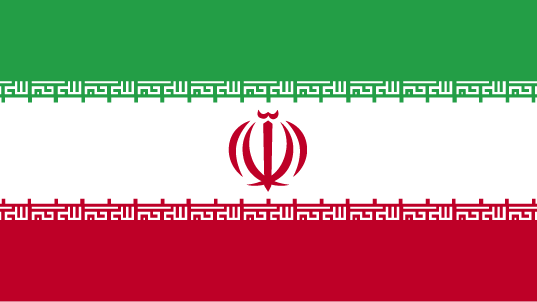Abstract
The Achaemenid Empire, which flourished from the 6th to the 4th century BCE, is known for its diverse and sophisticated cultural practices, particularly in terms of clothing. The Achaemenid period saw a complex system of dress codes that signified not only social status but also cultural and ethnic identity. Clothing in this era was characterized by richly adorned garments, often made from fine fabrics like wool and linen, with intricate patterns and colors. The aristocracy wore elaborate costumes, such as the "kandys," a long, flowing robe, while commoners had simpler attire. These clothes were used as symbols of power, ethnicity, and allegiance to the ruling elite. With the fall of the Achaemenid Empire, Iran's clothing codes evolved through successive historical phases, but the influence of the Achaemenid era remained significant in the cultural fabric of the region. Islamic and later dynasties introduced new attire styles, yet they often incorporated elements from earlier Persian traditions. Our problematic is: "How have the socio-cultural clothing codes of the Achaemenid era evolved over time, and what is their impact on contemporary fashion in Iran?" This problem explores the historical transformation of Persian clothing styles from the Achaemenid period to the present day, focusing on how these ancient codes have influenced modern Iranian fashion, especially in the context of cultural identity, social status, and political change. In contemporary Iran, the socio-cultural codes of dress have undergone significant transformations due to political and religious influences, particularly after the 1979 revolution. While modern Iranian fashion is heavily shaped by Islamic principles, there has been a resurgence of interest in pre-Islamic Persian history, including Achaemenid styles. Contemporary Iranian designers are revisiting Achaemenid motifs, using them to create a fusion of traditional Persian designs with modern sensibilities. The modern reinterpretation of these ancient dress codes serves not only as a form of cultural expression but also as a statement of national identity and resistance to Western influence. Thus, the legacy of Achaemenid fashion continues to shape Iranian clothing codes, bridging the ancient and contemporary through a blend of cultural pride and modern creativity.
-
Keywords: Iran, Fashion, meaning, socio-cultural code, semiotics
1. Introduction
Clothing plays a fundamental role in the construction of Iranian identity in the face of globalization as a cultural, political, and social expression that combines tradition, resistance, and adaptation to external influences (
Khosravi, 2017:30). Clothing in Iran is a complex field of expression where identity negotiations are continually shaped between modernity and tradition, individuality and collective norms, within a context marked by globalizing influences and internal power dynamics (
Najmabadi, 2005:22). In this text, we will discuss how it is possible to find new cultural identities in contemporary clothing design in Iran.
For the study of clothing in Iran, from one perspective, there can be two types of classification: first, the prehistoric era, which is mostly based on assumptions, conjectures, and hypotheses, and second, the historical period, where sources fall into two main categories: written texts and stone reliefs (
Fradique, 2019:18). The written texts are preserved in ancient, middle, and modern Iranian languages, thus presenting us with a vast corpus of material (
Hinz, 1987:23).
Linguistically, many of these texts belong to the Achaemenid period, though in terms of thought, they often stretch back to millennia before that (
Briant, 2002:19). Chronologically, their writing continues into the Islamic era (
Crone, 2004). For a coherent classification, it should be noted that by "written texts," we refer both to the Avesta and Old Persian inscriptions (
Boyce, 1975). Regarding Old Persian, it should be noted that this language was primarily used for historical events and, unlike the Avesta, has fewer literary aspects. The oldest Old Persian inscription dates back to Darius I (
Kent, 1953).
Alongside these written texts, we encounter stone reliefs that convey a wide range of meanings—many of which are communicated through clothing (
Curtis & Tallis, 2005). In the Avesta, clothing is primarily described in relation to the garments of divinities and the ritual dress of priests (
Boyce, 1984). However, in Achaemenid reliefs, attire serves as a marker of religious policy, ethnic and racial identity, and even climate adaptation (
Henkelman, 2012).
With the political, social, and even geographical changes in ancient Iran up to the arrival of Islam, we encounter two dynasties, each of which ruled Iran for more than four centuries: first the Parthian dynasty, and then the Sassanian dynasty. During these two long periods, clothing, like other cultural and social elements, underwent extensive changes (
Daryaee, 2009). Its motifs sometimes blended with foreign elements, the fabric materials better adapted to the climatic regions of Iran, and especially a kind of social classification among different levels and classes of society was created in clothing (
Canepa, 2018). In this article, we try to examine these transformations and their impact on contemporary fashion and clothing. Our problem is how Iranian identity is constructed through the socio-cultural codes of clothing.
A prevailing hypothesis suggests that contemporary Iranian fashion has seen a kind of return to Iranian, Achaemenid, Zoroastrian, and even pre-Zoroastrian concepts (
Sazmand, 2016). Therefore, the scope of source studies for constructing a comprehensive corpus can be based on ancient texts and how their meanings have evolved over time. We have limited the period of studying the evolution of clothing exclusively to ancient Iran due to methodological reasons and because of the specific issues we are addressing.
2. History of transformation of clothing
2.1 History of Clothing in the Achaemenid Empire
The Achaemenid Empire, which lasted from approximately 550 to 330 BCE, was one of the largest and most influential empires in ancient history. The clothing worn during this period reflected the empire’s vast cultural diversity, social hierarchy, and practical needs shaped by the climate and lifestyle of the region (
Briant, 2002). Regarding men’s clothing, men in the Achaemenid period typically wore tunics that reached down to the knees or lower. These tunics were often paired with trousers, a distinctive feature of Persian dress that differed from the robes common in many other ancient cultures. The trousers provided comfort and mobility, especially useful for horse riding and military activities (
Curtis & Tallis, 2005).
Over the tunic, men often wore cloaks or capes, which could be fastened with brooches or pins. Headwear was an important part of men’s attire. The "mitra," a type of soft hat or headband, was commonly worn and sometimes decorated with embroidery or jewels. The clothing of men, especially nobles and soldiers, was often richly decorated with intricate patterns and vibrant colors, symbolizing their rank and role within society. Typically, Achaemenid noblemen and courtiers are depicted wearing long, pleated robes with wide sleeves. These garments often reached the ankles and were belted at the waist, creating a structured and elegant silhouette (
Henkelman, 2012). The robes were likely made of wool or linen, though the precise fabric cannot be determined from the reliefs alone. The pleating, meticulously carved in stone, indicates a high degree of craftsmanship and possibly suggests an elite status.
In addition to the robe, a soft rounded cap or a tall, fluted headdress—sometimes identified as the bashlyk or tiara—was commonly worn. Footwear consisted of simple, flat-soled shoes, possibly made of leather, and sometimes high boots (
Daryaee, 2009). A particular note is the visual differentiation in attire used to represent the empire’s various subject peoples. The reliefs at Persepolis show delegates from different regions bringing tribute, each group distinguished by unique regional garments and headgear. In contrast, the Persian elites are consistently depicted in uniform court attire, emphasizing imperial identity and hierarchy. Thus, the clothing of Achaemenid men, as portrayed in stone reliefs, functioned not only as a marker of social and political status but also as a visual symbol of unity within the multicultural framework of the empire (
Canepa, 2018).
As for women’s clothing, unlike the relatively abundant depictions of male figures in Achaemenid stone reliefs, representations of women are rare, especially in official contexts such as those found at Persepolis (
Boyce, 1984). However, where women are portrayed—in seal impressions, glazed tiles, or funerary art—a general understanding of Achaemenid female attire can be reconstructed. Achaemenid women are typically shown wearing long, loose-fitting garments that extend to the ankles, similar in some respects to the robes worn by men but generally more elaborately decorated. These garments were often layered, with an underdress and a mantle or cloak draped over the shoulders and fastened at the front. The clothing appears to have been modest and voluminous, serving both aesthetic and cultural purposes related to decorum and status (
Henkelman, 2012).
Head coverings or veils were common, particularly among elite women. Some depictions suggest that women covered their hair with a scarf-like fabric, while others show a more structured headdress. Jewelry—such as earrings, necklaces, and bracelets—is frequently shown and may have played a significant role in expressing wealth and social rank (
Boyce, 1975). Although stone reliefs offer limited direct evidence, textual sources and comparisons with contemporaneous Near Eastern cultures suggest that aristocratic women in the Achaemenid court had access to finely woven textiles, possibly embroidered or dyed, and wore garments that reflected both Persian traditions and influences from the broader imperial world (
Fradique, 2019).
Women’s clothing in the Achaemenid Empire was characterized by long, flowing dresses that sometimes featured pleats or layers. These dresses often had short sleeves and were made from fine materials such as linen, wool, or silk (
Hinz, 1987). High-ranking women wore additional garments like rectangular veils or chadors, which covered their heads and shoulders, reflecting modesty and social status. Jewelry and accessories were also important for women, including necklaces, bracelets, and earrings, often made from gold and precious stones. The use of color and decoration in women’s clothing was significant, with elaborate embroidery and detailed designs showcasing wealth and position (
Sazmand, 2016).
In summary, while less visually documented than male attire, women’s clothing in the Achaemenid period reflects similar themes of modesty, formality, and social distinction, shaped by the broader political and cultural ethos of the empire (
Boyce, 1984).
In the Achaemenid Empire, clothing colors and styles were closely linked to social classes and professions. For example, soldiers often wore red garments, priests wore white, and farmers or commoners wore blue. Members of the royal family or the king himself sometimes combined these colors in their attire to symbolize their supreme authority over all social strata.
Regarding materials, the primary textiles used for clothing were wool, linen, and silk. Wool was widely available and commonly used for everyday garments, while linen was favored for lighter, cooler clothing suitable for the warm climate of much of the empire. Silk, imported from distant regions, was a luxury material reserved for the elite and indicated connections with the eastern regions of Iranian territory. Persian textiles were renowned for their high quality, vibrant dyes, and intricate embroidery, reflecting the advanced craftsmanship and sophisticated aesthetic of the period.
From both practical and aesthetic perspectives, Achaemenid clothing was designed to be elegant yet functional. Layering was common, allowing individuals to adapt to fluctuating weather conditions. The use of trousers and tunics facilitated ease of movement, especially for horsemen and soldiers. Meanwhile, intricate decorations and luxurious fabrics conveyed the wearer’s social status and cultural identity.
This rich tradition of clothing in the Achaemenid Empire served not only practical needs but also expressed the empire’s cultural sophistication and hierarchical structure. It left a lasting influence on Persian art and fashion. One of the most significant representations of clothing from this period is found at the Behistun Inscription.
2.3 Behistun
The Behistun Inscription (or Bisotun relief), carved into a cliff in western Iran during the reign of Darius I (522–486 BCE), is both a crucial historical text and a significant example of Achaemenid imperial iconography. The relief visually communicates Darius’s authority and legitimacy, and clothing plays an integral role in this depiction.
The central figure is Darius I, who stands taller than all others—a visual technique that emphasizes his importance. He wears a long, pleated robe characteristic of Achaemenid royalty, secured with a belt, along with a rounded, soft cap or tiara signifying his noble status. His raised right hand is in a gesture of authority or prayer, while his left hand holds a bow, symbolizing kingship in Persian tradition.
In front of Darius are bound captives representing rebel kings defeated in their challenge to his rule. Each captive wears distinct regional attire, reflecting their ethnic and geographic origins. This artistic choice highlights the empire’s vast diversity and the scope of Darius’s power. For example, Elamite, Babylonian, and Median rebels are shown in traditional regional clothing such as tunics, trousers, and unique headgear. The diversity of dress helps viewers identify the figures as foreigners or subject peoples, reinforcing Darius’s dominance over a varied empire.
Behind Darius stand two courtiers or guards (possibly Intaphrenes and Gobryas), dressed in Achaemenid court robes and Median-style garments, indicating their high rank and loyalty. Their attire combines Persian and Median elements, symbolizing the dual-ethnic power structure at the empire’s foundation.
A key figure is Gaumata, the usurper, shown lying trampled beneath Darius’s foot. Gaumata wears a robe similar to that of a noble but is depicted with less respect and in a position of physical subjugation, underscoring his illegitimacy. Here, clothing functions as a political message: the precise differentiation in garments legitimizes Darius’s rule by illustrating that he has conquered numerous nations whose leaders now stand humiliated as captives.
This imagery also symbolizes the theme of order versus chaos. The contrast between the orderly, elegant robes of Darius and his followers, and the disheveled, defeated appearance of the rebels, visually represents the triumph of order (Achaemenid rule) over chaos (rebellion).
2.4 Avestan Texts
The formation of the Avestan texts occurred before and during the Achaemenid era. These texts are not homogeneous; although linguistically they belong to the ancient Iranian language family, the ideas they present can be traced back to a much earlier period, likely linked to the time of Indo-European cultural coexistence. With the rise of the Achaemenid Empire, Avestan texts expanded in western Iran, incorporating new material over time.
Regarding clothing as mentioned in the Avesta, we encounter a similar heterogeneity, yet it is possible to identify a distinct type of ritual dress associated with Zoroastrians. In the Avesta—the sacred scripture of Zoroastrianism—clothing carries deep spiritual and symbolic significance, extending beyond social or cultural practices.
Two key garments are frequently emphasized: the Sudreh (a white cotton shirt) and the Kushti (a sacred woolen girdle). Together, these form the ritual attire of devoted Zoroastrians. The Sudreh is a simple, loose-fitting shirt made of white cotton, symbolizing purity, light, and goodness. It features a small symbolic pocket over the chest, known as the "pocket of good deeds," representing the good actions accumulated throughout life. The white color further signifies the sacredness of the plant kingdom, reflecting deep respect for creation.
The Kushti is a woolen girdle worn around the waist, wound three times to symbolize the Zoroastrian ethical triad of “Good Thoughts, Good Words, Good Deeds.” It consists of 72 fine threads, each representing a chapter of the Yasna—the primary liturgical text of the Avesta—and ends with tassels symbolizing other sacred texts and festivals. The tying of the Kushti is a ritual prayer performed multiple times daily. It involves specific gestures and recitations that reinforce spiritual discipline and protection against evil.
It is important to note that the Avesta does not prescribe specific dress codes for women’s modesty, such as mandatory veiling. Instead, it emphasizes clothing as an external manifestation of inner purity and commitment to righteousness. These ritual garments are worn beneath everyday clothing, serving as a constant reminder of one’s spiritual duties and identity as a follower of Ahura Mazda’s path. Overall, in the Avesta, clothing transcends physical necessity and becomes a sacred symbol of faith, ethical conduct, and connection to divine creation. The Sudreh and Kushti together embody the spiritual armor of Zoroastrians.
In this study, the focus has been deliberately limited to the ancient period of Iran, excluding an in-depth examination of the Arsacid, Sassanid, and Islamic eras. This methodological choice stems from the central premise of the research: contemporary Iranian fashion and cultural identity maintain a direct and profound relationship with the original ancient heritage, particularly that of the Achaemenid period and earlier.
While the Arsacid, Sassanid, and Islamic periods certainly represent important phases in Iranian history with their own distinct cultural contributions, they are, in the context of contemporary fashion discourse, better understood as intermediary layers—periods through which the ancient symbols, motifs, and meanings have been reinterpreted and resémiotized. In other words, these middle and later historical phases often act as transmitters or filters, mediating and adapting the ancient visual and cultural codes rather than introducing wholly new foundations.
By concentrating on the ancient era, we aim to investigate the primary source of cultural symbols and socio-political meanings embedded in clothing—symbols that modern Iranian fashion consciously revives, references, and redefines. The subsequent periods can be seen as part of a continuum, wherein the ancient heritage is preserved, transformed, and negotiated. Thus, although contemporary fashion resonates through the lens of the Arsacid, Sassanid, and Islamic layers, its roots and the most significant influences are traceable to the original ancient period.
This approach facilitates a clearer understanding of how Iranian identity, through clothing, is constructed today by engaging directly with the earliest cultural codes, rather than diluting this relationship by blending it equally with later historical phases. It recognizes the ancient period as the primary wellspring of cultural resonance, with the middle and Islamic eras playing supporting, though essential, roles in the transmission and reinterpretation of those ancient traditions.
3. Semiotic and Epistemological Study of Fashion in Iran
When we talk about the semiotics of fashion and clothing, above all else, we must acknowledge that this type of semiotics is not based on a coherent and uniform method. This is because, in most books and articles written about fashion and semiotics, we see the inseparable link of fashion and clothing both with history on one hand, and on the other hand with society and culture. Therefore, fashion and clothing always have a historical, social, anthropological, and cultural context. The same issue is evident regarding clothing in Iran: many of today’s Iranian garments and fashion designers who turn toward Iranian clothing are building their principles based on this historical background, which begins from the Achaemenid era. In fact, the reason we started from the Achaemenid era and connected it to the Avesta is that our foundation is history, and one cannot separate modern humans from their history. On the other hand, in the Avesta, we also see that clothing and decoration are inseparable mythological elements. It must be admitted that if the mind is capable of creating diverse images, it can be imagined that such clothing was conceivable in a certain historical period. Clothing at the beginning of Iran’s historical era was never merely a covering but also held importance as decoration; no garment was without adornment and beauty. Iranian clothing is a sign of Iran’s geographical context as well: in the eastern regions, one type of clothing was common, while in the western regions, a different type prevailed. In western regions, the connection between Iranian peoples and Mesopotamian and Semitic elements was more evident, whereas in eastern Iran, the clothing showed closer ties with Sogdian, Khwarezmian, and Balkh elements.
To understand the meaning of fashion in Iranian society, we must explore both its practical and aesthetic dimensions. Iranian society places great importance on social cues expressed through clothing and personal style, often seeking to decode the cultural connotations embedded within appearance. Clothing and its assembly create a distinctive social identity that in turn forms “fashion.” As Greimas aptly states: “Fashion defines a particular social dynamic and strives to expose the cultural phenomenon and its vocabulary in the form of a sustained discussion focusing primarily on its semantic dimension... identifying significant words in the social domain” (
Greimas, 2018: 49).
As we said from the beginning, Fashion in Iran has a long and rich history, evolving in parallel with global fashion developments. This evolution has inspired many Iranian fashion designers, artisans, and creators to develop concepts that resonate deeply within Iran’s unique socio-cultural context. As a cultural and social phenomenon, fashion has expanded far beyond its original association with clothing and consumer objects tied to capitalist society and the bourgeoisie. Over time, the scope of fashion has widened from garments to non-clothing items, and from mere consumer goods to decorative and artistic objects. In the past three decades, the boundaries between artistic disciplines have blurred, resulting in interdisciplinary expressions and hybrid languages within the fashion domain. Now, we are going to explain some patterns and motifs.
3.1.1 Motifs
Motifs in Iranian fashion have deep roots in traditional Iranian art and culture, forming an essential part of the visual identity of Iranian clothing and jewelry. Key motifs include:
Plant Motifs: Such as Boteh Jegheh, Eslimi, and Khataei, characterized by flowing, curved lines symbolizing life and movement. For example, Boteh Jegheh often represents the flame or the tree of life, while Eslimi features elegant spirals, frequently embellished with colorful stones in jewelry.
Animal Motifs: Derived from mythology and ancient symbolic traditions. Notable examples include the lion and sun, symbols of power and endurance, and Simurgh, representing wisdom and knowledge. These motifs appear in both textiles and jewelry.
Geometric Motifs: Complex patterns involving stars, polygons, and repetitive shapes that not only embellish, but also convey philosophical and spiritual meanings. These occur frequently in both fabrics and jewelry.
Calligraphic Motifs: The use of Nastaliq calligraphy featuring Quranic verses, Persian poetry, or culturally significant phrases carved or embroidered onto clothing and accessories, adding layers of aesthetic and symbolic meaning.
These motifs influence both traditional and contemporary Iranian fashion, embodying a blend of heritage and innovation. Many designs considered modern in global fashion bear roots in ancient Iranian traditions, highlighting Iran's enduring global influence.
In summary, motifs in Iranian fashion serve as cultural and historical symbols, imbuing garments and jewelry with identity that reflects Iran’s art, beliefs, and history
3.1.2 Religious Codes
As discussed in the section on the history and evolution of clothing in Iran, part of today’s sartorial transformations trace back to Zoroastrian religious texts and traditions. For instance, the Sudreh and Kusti, ceremonial garments in Zoroastrianism, retain their basic external forms but have acquired new symbolic meanings over time. Notably, these garments are worn today not only by Zoroastrians but also by many non-Zoroastrian Iranians.
The Sudreh and Kusti symbolize the cosmic struggle between good and evil, embodying the ethical battle against Ahriman (the destructive spirit) fundamental to Iranian mythology. Contemporary Iranian fashion designers have, in some cases, reinterpreted and redesigned these garments, incorporating their symbolic meanings into modern clothing. Typically, white, these garments—made of cotton and linen blends—represent purity, simplicity, and the protection of elemental forces.
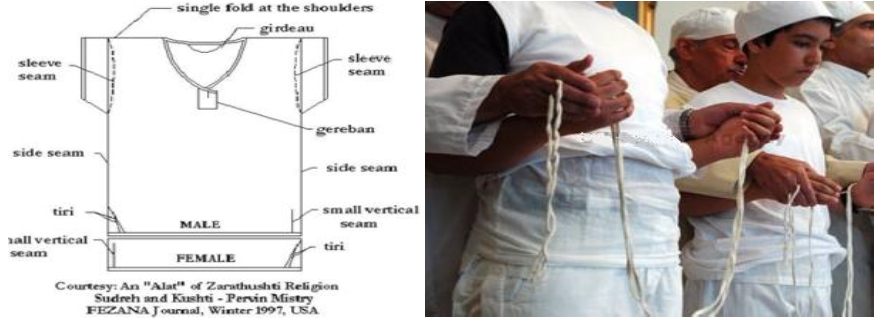
Iranian clothing transcends borders, creating a kind of unity between different peoples, while maintaining the distinctiveness of each ethnic group and individuality. This type of clothing is designed both to protect the body and to symbolize diversity and variety in unity. Iranian clothing, originating from two historical-national and literary-religious (Avestanic) sources, represents a blend of myth and history. Therefore, such garments can be traced both with mythological data and historical evidence. In today’s Persian language, many clothing-related words have ancient roots in Iran’s ancient languages, though their meanings have evolved, undergoing various semantic and linguistic processes to reach their current forms.
The clothing of Iranian peoples has also been connected and related to the attire of Indian peoples, since at one point in history, the mythological ties between Indians and Iranians were inseparable, and as these two peoples separated, their clothing likewise became distinct. Hence, our most emphasized point is that this clothing has always aimed to transcend borders and is never static.
4. Conclusion
In summary, the concepts of ancient Iranian fashion represent a millennia-old heritage, rich in ethnic and cultural diversity, expressed through clothing that was simultaneously practical and highly decorative. This tradition evolved through myriad influences stemming from successive dynasties, religious beliefs, and regional interactions long before the modern era brought new syntheses and transformations.
Today’s fashion tends toward the unification of clothing styles, colors, and sizes in an effort to reduce social and political class distinctions—an attempt to create a more egalitarian appearance. In contrast, in the past, social hierarchies were clearly visible and almost impossible to transcend through clothing. The historic complexity of Iranian dress reflected a layered social order that modern fashion now challenges or reinterprets.
Thus, by focusing on the ancient period, this study highlights the deep roots of Iranian identity encoded in clothing and fashion, which have been constantly transformed yet remain relevant in contemporary Iranian cultural expression.
Figure 1.
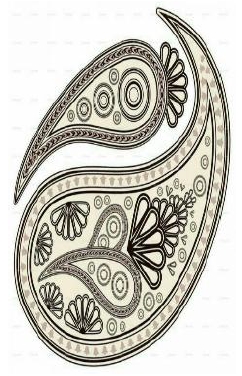
Figure 2.
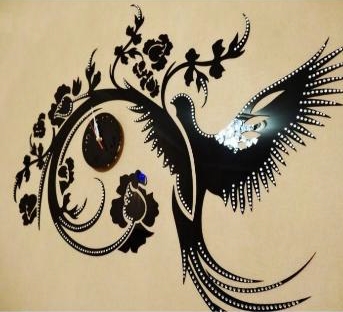
Figure 3.
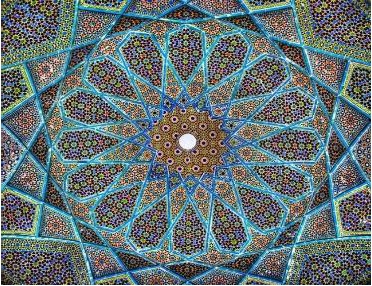
Figure 4.
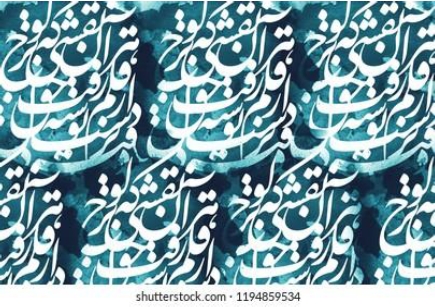
REFERENCES
- Boyce, M. (1975). A History of Zoroastrianism Vol. 1. Brill.
- Boyce, M. (1984). Zoroastrians: Their Religious Beliefs and Practices. Routledge & Kegan Paul.
- Briant, P. (2002). From Cyrus to Alexander: A History of the Persian Empire. Eisenbrauns.
- Calmeyer, P. (2018). Art in Iran: iii. Achaemenid art and architecture. In Encyclopaedia Iranica. https://www.iranicaonline.org/articles/art-in-iran-iii-achemenian/
- Canepa, M. P. (2018). The Two Eyes of the Earth: Art and Ritual of Kingship between Rome and Sasanian Iran. University of California Press.
- Cool Root, M. (2021). The King and Kingship in Achaemenid Art: Essays on the Creation of an Iconography of Empire. Peeters Publishers.
- Crone, P. (2004). The Nativist Prophets of Early Islamic Iran. Cambridge University Press.
- Curtis, J., & Tallis, N. (2005). Forgotten Empire: The World of Ancient Persia. University of California Press.
- Daryaee, T. (2009). Sasanian Persia: The Rise and Fall of an Empire. I.B. Tauris.
- Fradique, A. (2019). Prehistoric Iranian Clothing: Hypotheses and Evidence. Journal of Ancient Cultures, 14(2), 45-60.
- Greimas, A.J. (2018). Fashion in 1830. PUF.
- Henkelman, W. F. M. (2012). Ethnicity and Clothing in Achaemenid Reliefs. Iranica Antiqua, 4793-130.
- Hinz, W. (1987). Handbuch der Altpersischen Inschriften. De Gruyter.
- Kent, R. G. (1953). Old Persian: Grammar, Texts, Lexicon. American Oriental Society.
- Khosravi, S. (2017). Clothing and Identity in Contemporary Iran. Middle Eastern Studies, 53(4), 607-622.
- Kuhrt, A. (2007). The Persian Empire: A Corpus of Sources from the Achaemenid Period (includes translation and visual analysis of inscriptions and reliefs). Routledge.
- Lindsay, A. (2005). The Persian Empire: A Corpus of Sources from the Achaemenid Period. University of Chicago.
- Najmabadi, A. (2005). Women with Mustaches and Men without Beards: Gender and Sexual Anxieties of Iranian Modernity. University of California Press.
- Sazmand, A. (2016). Reinventing Tradition: Achaemenid Revival in Iranian Fashion. Fashion Theory, 20(3), 365-38.
- Schmitt, R. (2016). Bisotun: iii. Darius’s inscriptions. In Encyclopaedia Iranica. https://www.iranicaonline.org/articles/bisotun-iii/
- Shahbazi, A. S. (2016). Darius: iii. Darius I the Great. In Encyclopaedia Iranica. https://www.iranicaonline.org/articles/darius-iii/
35
